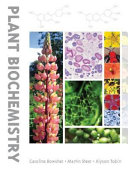Plant Biochemistry
| Series: | |
| Publisher: | Garland Science |
| Subject: | Botanical chemistry. |
| Authors: | Caroline Bowsher , Martin W. Steer , Alyson K. Tobin |
| Pages: | 446 pages |
| Binding: | Hardcover |
| ISBN: | 9780815341215 |
| Call No: | QK 861. B69 2008 |
The biochemistry of plants is distinct from that of other organisms for two main reasons: they are autotrophic and sessile. Plants can’t move away from environmental stress or predation, so their biochemical pathways are particularly flexible and examples are given throughout of how plants respond to environmental challenges. As plants are autotrophs, many biochemical pathways that are catabolic in non-autotrophs, have an anabolic function in plants. Photosynthetic, biosynthetic and respiratory pathways and their regulation are covered in detail, emphasizing the influence of the environment e.g. the biosynthesis of alkaloids, phenolics, and terpenoids by which plants produce chemicals to deter herbivores and the complex carbon concentrating pathways of C4 photosynthesis and of Crassulacean Acid Metabolism. Another result of autotrophy covered is the acquisition of other elements, such as nitrogen and sulfur, and minerals that are needed for plant growth and development. Also included is plant cell structure, and how the compartmentalization of many biochemical pathways is used as a regulatory mechanism. Metabolic pathways are represented as route maps, showing how one reaction follows another, but it is important to see these pathways as dynamic processes that do not operate in isolation. It is therefore a theme of this book to set biochemistry in the context of the function and response of the whole plant, reflecting that current progress is taking place using systems-based approaches, where there is a realistic hope of understanding the interlinking processes of biochemical and gene regulation. Important methodologies that look at the whole plant e.g. metabolomics are introduced in boxes throughout the text.

